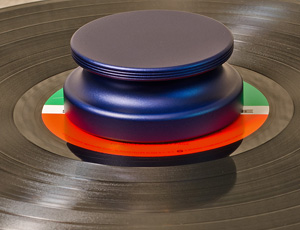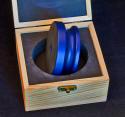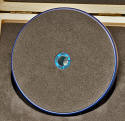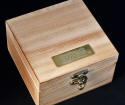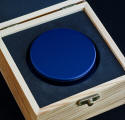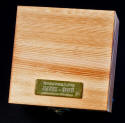-edible zone-
- Component Review: Riverstone Audio Jazz 380 Record Weight
- Category: Accessories
- Review period: 3 weeks
- Weight: 380 grams
- Dimensions: Diameter at largest perimeter: Ø80 mm (3.15 inches)
- Dimensions: height overall: 34.5mm (1.358 (inches)
- Method of manufacture: CNC Lathe-turned
- Material: Aluminum 7071 - T6 (an aerospace grade aluminum used largely for milled structural components in commercial and military aircraft)Finish Aluminum: Anodized plating in Ocean Blue shade. Surface prep prior to plate appears to be shot peen.
- Material: damping pad: EVA foam 1mm thick adhered to the bottom of the weight to contact the record label.
-- Note: the Jazz 380 Record weight comes with its own custom foam-packed wood case to protect it while not in use. A nice touch!
--Record weights, by design, use their mass to push the record
downward into the record mat on the platter. Ideally this results in a
more intimate area of contact between record and mat. These (record
weights) are not to be confused with other similar devices such as
record clamps. Record clamps come in two popular configurations, a
screw-down clamp or a compression clamp. The screw-down clamp requires
that the platter spindle has machine screw threads to match the threads
within the clamp and then the clamp screws down over the record putting
it (the record) into a more intimate close contact with the platter mat
beneath it than it would be if not clamped. The compression clamp does
not require a threaded spindle, rather it has a compression joint within
its center hole designed to grip the smooth spindle pin while being
pressing the record down into the mat. Personally, I really like the
screw-down type of clamp .... but very few turntables offer a threaded
spindle pin, so this is frequently not an option and then we are left
with the options of the using record weight, a compression clamp or
nothing.
Additionally, there will be some instances where no
discernible difference can be heard while playing the same record with
weight or without weight. Still other times the difference will be
plainly evident. Different turntables with different platter mats will
respond differently, or not at all, and the owner of this product is
left to trust his/her own senses as to its effectiveness. Welcome to the
world of record playback and all the little mystic 'white rabbit' holes
one can crawl down into.
Record weights have a somewhat
controversial reputation about them. Some folks embrace the idea of a
record weight, while others will decry them, stating that the weight
merely adds mass directly over the thrust pad of the main platter
bearing and therefore accelerates wear at the bearing thrust. Still
others may note that their particular turntable bearing is robust enough
to not suffer any increase in rate of wear, while others note that their
particular turntable has a bearing that allows for routine maintenance
to replace thrust pads as well as bushing sleeves, and therefore those
individuals are not troubled by the idea of adding another 380 grams of
mass over the tip of the thrust.
For myself, I find that some
turntables do warrant concern about wear at the bearing thrust due to
the fact that some of those bearings do not allow for thrust pad
replacement and this is indeed a valid concern. Especially on the
lighter, less robust bearing designs. Still other turntables that I
currently own, or have owned in the past, do allow for bearing
maintenance and with those I am not overly concerned about adding mass
over the thrust. In this instance the turntable I am testing this record
weight does allow bearing maintenance as well as replacement of the
thrust pad, bearing thrust ball and also the bushing sleeves within the
bearing housing, so I'm happy to give this a go. And...this is not the
first record weight I have evaluated on the turntable. Bearing
maintenance is carried out periodically in my situation.
Something to keep in mind; The record itself has mass, and we load them
onto the platter without a second thought. Anyone ever own a record
changer? Back in the day it would be common to see as many as a stack of
three or four records having been dropped down onto the platter. Figure
a normal record weighs around 100 to 130 grams each. Today we see
audiophile records that weigh between 180 to 200 grams each. And now
here we have a record weight that weighs 380 grams. So what! Let's keep
some perspective and not get too panicky about details that have not
been fully thought through. Of course the turntable designers were
careful to consider how much load their platter bearings could handle.
I received this accessory for evaluation from a client for whom I am
working on a turntable. So I am happy to evaluate the product and
publish my impressions and observations within this review. When his
turntable project is done this record weight will return home with its
owner.
Impressions: This item is popularly priced (at the time
of this writing) around the web at approximately ~$39.99. When you
consider that a suitable length and diameter of round bar in aircraft
grade aluminum was used on modern cnc machine tooling it does indeed
seem like a bargain. Certainly nothing of the sort could be produced
within the United States that would; pay the manufacturer, pay the
intermediaries within the dealer/distributor network , turn a profit for
the entire chain and still be sold at this price,..... not in the United
States, anyway. There is no indication as to where this piece was made
so that question will go unanswered. Nor do we know what country this
was manufactured in. What I can note, however, is that the level of fit
and finish quality is impressive. I see no visual evidence of off-axis
run-out while the weight spins about the bearing axis on the turntable.
I can note that with the combination of turntable and mat there is an
audible benefit to using a record weight. I keep a few of my own record
weight and clamp designs around and take note of what differences in
sound I do or don't notice. But just how much difference does it make --
audibly? Hardly anything at all. Just a subtle sense of greater silence
in the background. Perhaps just a tad more definition on the inner
details. Nothing huge. A tiny improvement if at all.
When we
think of the process of playing a record, with the stylus in the groove,
riding over the microscopic-sized chiseled patterns of sharp little
steps spaced just so that at a given set speed these create sound waves
we discern as music. Apart form the music we hear through our speakers,
what we have is a lot of microscopic vibration going on between stylus
and groove, and it should come as no surprise that not only does the
stylus and cantilever vibrate while doing this, so too does the record
itself vibrate while undergoing this process. Different types of platter
mats will dampen record vibes more or less effectively than do others.
And in fact a record weight or clamp can also serve to help damp record
vibrations. What we can hope for is that record vibration is
reduced/damped by the combination of record weight and platter mat
working together to dampen the record from these parasitic vibrations.
And when record vibrations are in fact reduced the audible benefits can
be anticipated as a cleaner less noisy pick-up at the stylus groove
interface. We might hear a subtle improvement in clarity. It could mean
an improvement in a particular sound frequency approximate to that being
tracked by the stylus. Expect a sense of improved clarity in a frequency
specific to the music being played.
At $40 clams for a nicely
machined bit of anodized aluminum, you won't be out much if you don't
hear any improvements. Even if you buy this but don't really hear an
improvement; hang onto it and the next platter mat you try may make an
audible difference and in combination with that platter mat, you might
think you heard another improvement while using the Jazz 380 clamp. An
accessory that won't break the bank and you may actually like it for
more than just decoration. Recommended for those already inclined.
You can read more about this record weight at the Riverstone Audio
website, from where this product is marketed.
Here's a link:
https://www.riverstoneaudio.com
-Steve
Equipment
used in this review:
Thorens TD124 turntable fitted with an
Infinity Black Widown tonearm, with a Sonus Blue cartridge mounted.
Overhang alignment per Stevenson.
Classe' CAP 151 integrated
amplifier with built-in phono stage at 47 k input.
Phono
cable/interconnect: Custom silver wire built by Garth Phillipe at
Incognito (circa 2005)
NHT 2.9 tower loudspeakers
